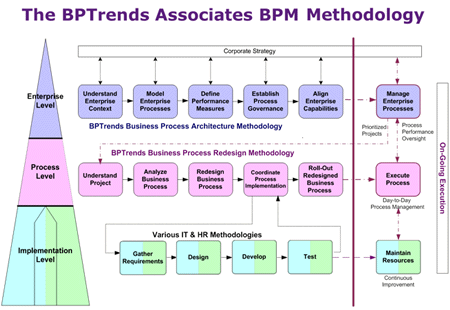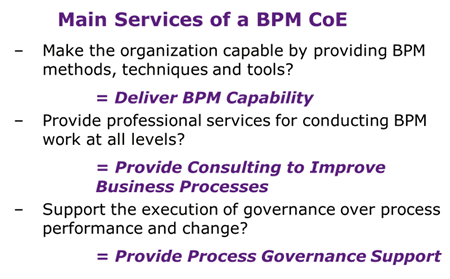BPM Critical Success Factors: Lessons Learned from Successful BPM Organizations
Introduction
In the last 24 months I have worked on six continents with dozens of organizations assisting them in developing and implementing their BPM programs. These organizations represent a broad range of industries, including capital intensive resource industries and manufacturing and distribution, customer service, finance, and government organizations. I have seen a lot of disappointing examples of Business Process Management but I have also seen some very good examples of BPM in organizations where BPM has been implemented well and is delivering improved and sustainable performance improvement. I have seen many alternative approaches and observed the practices and principles that mark the difference between failure and success. I have synthesized these observations into a set of principles I believe constitutes an approach to BPM that will assure sustainable management of an organization's process assets. In this Article I highlight ten principles that successful organizations follow in their BPM practice.
1. BPM is a business strategy to deliver business performance improvement and sustainability.
Every successful BPM organization that I have observed has used BPM to improve business performance in the pursuit of one or more strategic objectives. Successful BPM teams never lose sight of the strategic performance objectives and they use these drivers to demonstrate to management that BPM is not just a "nice to have" capability. They know that measurable results are required to demonstrate success and they use some combination of the following criteria to demonstrate success.
- Make work less costly
- Drive higher revenues and market share
- Bring products and services to market faster
- Keep products and services in market longer
- Enable continuous performance improvement
- Enable new products and services that are more flexible and easier to change and sustain
Figure 1 shows some of the results that performance improvement should bring.

Figure 1. Performance Improvement Focus.
2. BPM is a mechanism to assure traceability of business performance.
Successful organizations start at the strategy level and avoid 'Silos of Excellence" and stand-alone capability development. Development of Strategic Intent (ends) that provide mission, vision, goals and objectives are common, but successful organizations translate these into a sub-set of integrated and manageable strategies and programs that integrate changes in capabilities from related domains, such as information, organization and technology. The critical requirement is cascading the measurement indicators by measuring processes that contribute to the strategic objectives in a traceable and reportable way. They may or may not employ a balanced scorecard but it is the process hierarchy that organizes the performance reporting structure. The outcome is that their investments in change are driven by potential and traceable performance results. BPM is the best way to link the strategic intent to an integrated program of multidimensional change. Figure 2 illustrates the reciprocal connections from strategy to projects and back.

Figure 2. Traceability of Performance.
3. BPM is a mechanism to assure alignment of all required actions and capabilities of the organization.
It is clear that modern organizations are faced with many elements that have to work together in order for the organization to be effective. Alignment among these elements is often missing. Leading organizations make sense of these elements by using business processes as the vehicle to integrate and align the following:
- Strategies
- Performance
- Technologies
- Rules
- Information
- Knowledge
- Facilities and Equipment
- Organization
- Human Resources
Figure 3 shows the Burlton Hexagon that shows the process and performance based alignment of required organizational capabilities.

Figure 3. The Burlton Hexagon.
4. BPM is driven by satisfying outside stakeholder requirements.
Successful process organizations understand that doing process work from the inside out, or by department, is risky, at best. Meeting the needs of a single external group without considering all of the others can also lead to sub optimization of performance and downstream problems in sustaining the benefits. The challenge is to find the optimal balance among the set of external stakeholders and their potentially conflicting needs and expectations. A partial list of stakeholders includes:
- Customers
- Consumers
- Suppliers
- Regulatory bodies
- Owners
- Competitors
- Staff
Each of these entities exchanges products and services with the organization. Successful process organizations examine the exchanges, needs, and expectations to derive outcomes and targets for the enterprise processes that produce or consume the exchanges. The stakeholders are the beginning and end of all value streams and define the outcomes required to drive process design.
Figure 4 displays the types of outcomes that must be aligned to support our strategic intent, stakeholder relationships, and value added processes.

Figure 4. Alignment of Stakeholder Outcomes.
5. BPM requires a consistent business process architecture with a structured semantic vocabulary.
A sure fire way to fail in BPM is to have a poor process architecture. Great process organizations have a single well defined hierarchical and interconnected map of business processes and they use that map for all purposes; measurement scorecard foundation, compliance reporting, enterprise architecture and business process management, to name a few. The best maps I have seen are driven by the stakeholder exchanges from which the value stream processes are derived. These are consolidated into one common architecture describing what the enterprise does (the "how" comes later). For the advanced process centric organization this map provides a common language of the work that is done. It is independent of the organization chart and survives reorganization realignment so long as the business mission remains intact. Figure 5 illustrates the integration of select internal relationship and asset processes into a value stream that connects to the stakeholders.

Figure 5. Process Architecture Consolidation.
6. BPM requires a shared commitment to a set of foundational principles.
Successful organizations have learned a lot while on the journey and they have established a set of principles based on common sense and lessons learned. Typically, these principles cover key issues such as naming, notations, ways of viewing processes and other guidelines. More importantly, successful organizations are passionate and strict about their use. They are diligent in assuring that the entire organization knows them and applies them consistently across the whole organization. Successful organizations treat BPM as a professional discipline requiring a solid foundation. Figure 6 illustrates the top-level set of principles developed by BPTrends Associates for establishing a business process discipline.

Figure 6. The Business Process Manifesto.
7. BPM requires a common comprehensive methodology to guide business process change.
More mature process-centric organizations consistently follow a comprehensive methodology that integrates the enterprise-wide process architecture, governance and measurement system with the process redesign methodology and the implementation of a broad set of enabling capabilities such as IT, HR, facilities and rules. Many organizations employ other techniques such as Lean and Six Sigma, some have a process architecture to support IT planning or a scorecard system and some have defined an approach for implementing a BPMS technology. Many organizations use more than one approach at any of the three levels. But, successful organizations have one methodology that links strategy, process redesign, and implementation that allows various tools and techniques to be accommodated. The BPTrends Associates Methodology is shown below in Figure 7.

Figure 7. The BPTrends Associates BPM Methodology.
8. BPM requires a governance framework that evolves with Business Process Management maturity.
As an organization increases in terms of their BPM maturity, their process governance framework becomes more sophisticated and their commitment to it becomes greater. These organizations understand that corporate management is not process governance and that both are needed. The process governance framework monitors process performance and prioritizes a program of process change based on a process architecture. Those who are not yet working at the enterprise level realize that the appropriate degree of governance is required at the process improvement (project) level since without a process architecture, there is no basis for cross – process discussions. If mature enough, they can conduct formal investment prioritization based on strategic alignment (gain) and performance gaps (pain).

Figure 8. Maturity and Governance.
9. BPM requires a commitment to marketing, communication, education, training, and collaboration.
Mature organizations have realized that increasing process management capability does not guarantee success. BPM programs and projects will only be successful if the organization understands and supports the BPM program and is ready for change. Therefore, their BPM programs include developing BPM capabilities and organizational readiness concurrently. Having a capability is not the same as readiness and success will be severely constrained without a clear understanding of the readiness required and a plan in place to achieve the readiness. This is not well recognized by organizations that are new to BPM who typically assume that building BPM capability will naturally lead to BPM adoption. Unfortunately, the natural human and organizational resistance to change is very strong, especially when the motivation and incentive systems encourage resistance. All of the successful organizations have spent significant resources educating and training management and staff to support BPM. Figure 9 highlights some steps in establishing the communications required to deal with concerns of the stakeholders that will be affected by any BPM program or project.

Figure 9. Human Communications Program.
10. BPM requires a Centre of Expertise (CoE) to assure consistency, repeatability, and sharing of knowledge and insights.
Organizations that have had success in their BPM launch and ongoing operations almost always have a BPM CoE. The CoE establishes standards to enable consistent models and sharing of knowledge. The CoE delivers tools, methodologies, techniques, and training for use across the enterprise and supports initiatives and projects at all levels (enterprise, process and implementation) by participating, facilitating, and assuring the quality of activities and deliverables. It also provides support for executives involved in the governance process.

Figure 10. BPM CoE Services.
Summary
Organizations with successful BPM programs have worked hard to transform themselves from traditional silo based organizations to process centric organizations. BPTrends Associates has worked with many of these organizations and we have learned a great deal from understanding their "businesses" and supporting their business process change programs. We have incorporated these lessons learned into our BPTA Training Curriculum/Certificate programs and our Consulting services and we are committed to continuing to apply our knowledge and experience as we continue to work with our clients to deliver successful BPM Programs.# # #
About our Contributor:
Online Interactive Training Series
In response to a great many requests, Business Rule Solutions now offers at-a-distance learning options. No travel, no backlogs, no hassles. Same great instructors, but with schedules, content and pricing designed to meet the special needs of busy professionals.












How to Define Business Terms in Plain English: A Primer
How to Use DecisionSpeak™ and Question Charts (Q-Charts™)
Decision Tables - A Primer: How to Use TableSpeak™
Tabulation of Lists in RuleSpeak®: A Primer - Using "The Following" Clause
Business Agility Manifesto
Business Rules Manifesto
Business Motivation Model
Decision Vocabulary
[Download]
[Download]
Semantics of Business Vocabulary and Business Rules